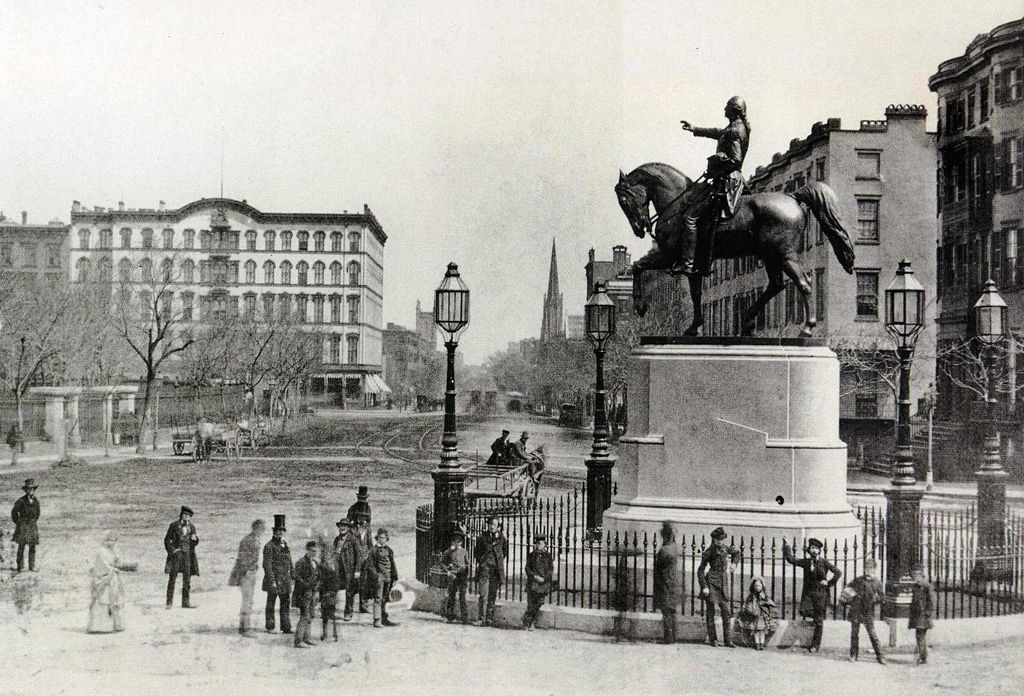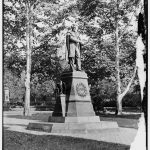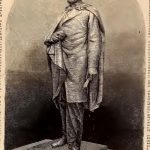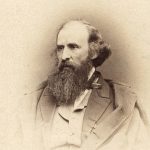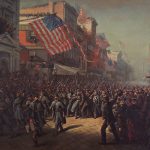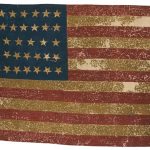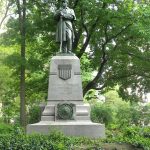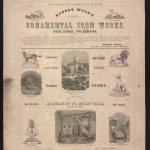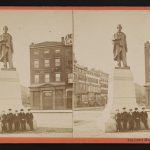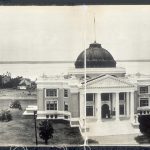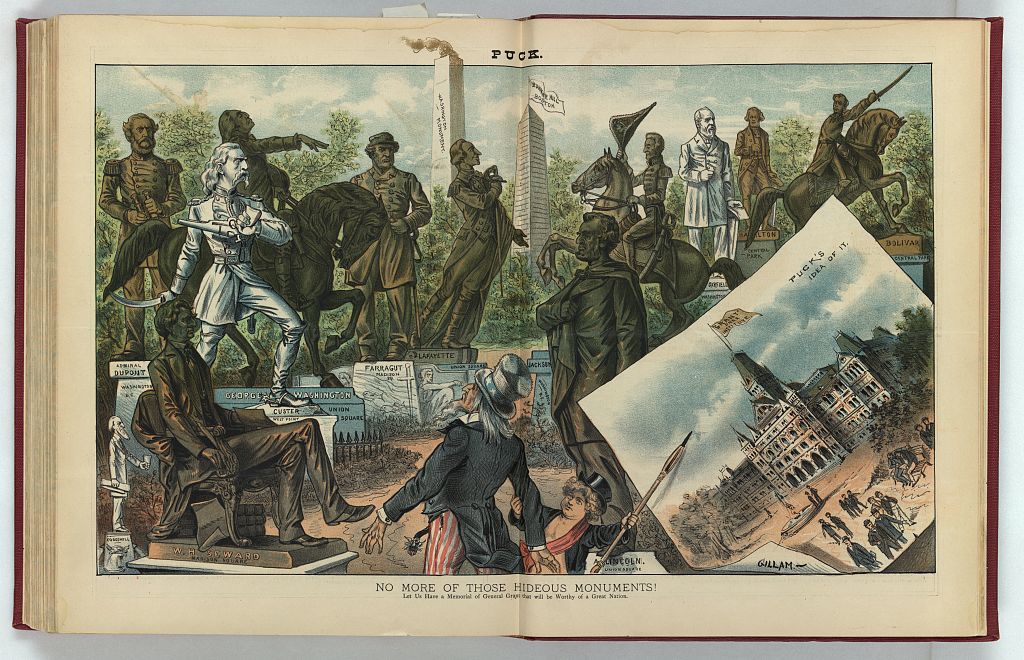Apparently some people politicized public monuments 150 years ago. From the October 8, 1870 issue of Punchinello (at Project Gutenberg):
“SOLEMN SILENCE.”
Perhaps very few persons—and especially very few members of the Republican party—are aware that a monument to ABRAHAM LINCOLN has at last been completed, and that it has been placed on the site allotted for it in Union Square. It is very creditable to the Republican Party that they exercised such control over their feelings when the day for unveiling the LINCOLN Monument arrived. Some parties might have made a demonstration on the occasion of post-mortuary honors being accorded to a leader whom they professed to worship while he lived, and whom they demi-deified after his death. No such extravagant folly can be laid at the door of the Republican Party. “Let bygones be bygones” is their motto. They allowed their “sham ABRAHAM,” in heroic bronze, to be hoisted on to his pedestal in Union Square in solitude and silence. That was commendable. A live ass is better than a dead lion; and so the Republican Party, who consider themselves very much alive, went to look after their daily thistles and left their dead lion in charge of a policeman.
It’s true I didn’t see anything in Harper’s Weekly about the unveiling, but about seven months earlier the publication did mention that the statue was going to be erected and provided an illustration.
_________________________
From the February 26, 1870 issue of Harper’s Weekly:
STATUE OF ABRAHAM LINCOLN.
We give above [in the center] a picture of the bronze statue of ABRAHAM LINCOLN by the distinguished artist, Mr. H.K. BROWN, which is to be placed opposite the equestrian statue of Washington, by the same artist, at the lower end of Union Square, in this city. In some respects this statue is an improvement upon the one executed by the same artist for Prospect Park, Brooklyn, of which we gave an engraving in the Weekly for November 13, 1869. The attitude and expression are full of dignity and repose, and the work reflects great credit on the artist.
The statue was cast at the foundry of Messrs. ROBERT WOOD & Co., of Philadelphia, to which the public is indebted for many works of great artistic excellence, one of the principal of which is the cast of the statue of a “Citizen Soldier,” by Mr. QUINCY WARD, of this city, for the New York Central Park.
I think in 1870 The New-York Times was Republican-leaning. On the front page of its September 11, 1870 edition it explained that workmen were preparing the monument and gave details about its appearance and the materials used. For example there were 36 stars representing the number of United States during Mr. Lincoln’s presidency (after Nevada joined up in 1864). The article also mentioned that the monument was ordered by the Union League Club[1].
According to the New York City Parks website the Lincoln statue in Union Square was dedicated on September 16, 1870. You can read much more about Henry Kirke Brown and John Quincy Adams Ward at The Met. Karen Chernick’s post at Hidden City Philadelphia tells the story of the Robert Wood foundry.
Harper’s mentioned John Quincy Adams Ward’s “Citizen Soldier” in Central Park. It must be the memorial to the Seventh Regiment, although that wasn’t dedicated until 1874.
A citizen-soldier type monument in Louisiana has had a tumultuous time recently. According to The South’s Defender on August 13th this year the Calcasieu Parish Police Jury voted to keep The South’s Defenders Memorial Monument standing in place outside the parish courthouse, despite calls for its removal. But CBS News reported that the statue was knocked off its pedestal on August 27th, apparently by Hurricane Laura. You can read a history of the monument at The South’s Defenders Memorial Monument. The most recent time the statue was toppled was during a windstorm back in 1995. You can read a case for removing the monument at change.org
I got the photograph of Washington Monument in Union Square (c1870) at Wikimedia; The photograph of Henry Kirke Brown is also from Wikimedia and also c1870. Maybe three times really is a charm, at least Wikimedia is also the place I found Jim.henderson’s photo of the 7th regiment statue, which is the 7th Regiment National Guard – you can read much more about the regiment and the statue at Daytonian in Manhattan; the 7th was designated the 107th for World War I. Thomas Nast’s The Departure of the 7th Regiment
To the War, April 19, 1861 (1869) and the 7th’s National Color come from the NY State Military Museum
From the Library of Congress: Lincoln’s statue in Prospect Park; Robert Wood’s advertisement; Lincoln in the square; South’s Defender at the Courthouse in 1923; the monumental centerfold from the August 19, 1885 issue of Puck – it looks like the Washington and Lincoln Union Square statues made the pic;
[September 28, 2020]: I added the single quotes in the title. That’s Punchinello’s concept as the publication was apparently having some fun with local Republicans. Also, last night I read a current article that gave Union Square a relative thumbs up. In “The Death of Public Beauty” Michael J. Lewis bemoaned modern public spaces that are “fragmented and disjointed.” “Perhaps the worst offender in this regard is Chicago’s Millennium Park. whose different features were funded independently by individual donors, making it less a unified design like New York’s Union Square than a series of discrete naming opportunities.” That is on page 29 of the September 21, 2020 issue of National Review.
- [1]The New York Times The Complete Front Pages 1851-2008. New York: Black Dog and Leventhal Publishers Inc., 2008. DVD.↩

